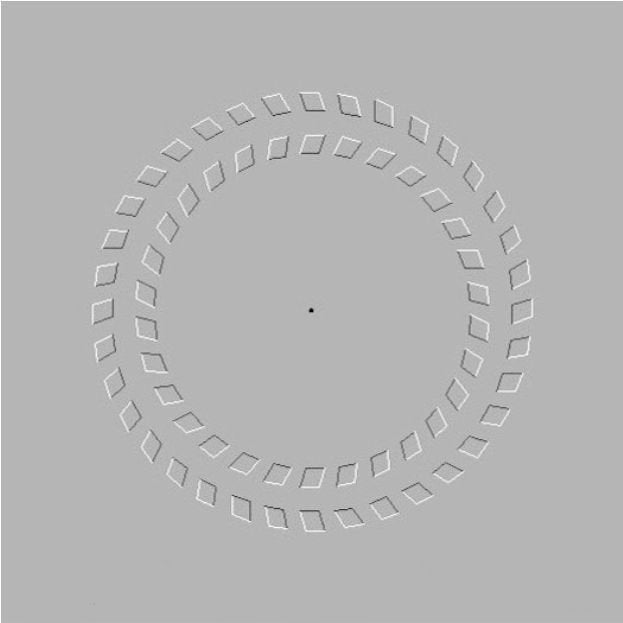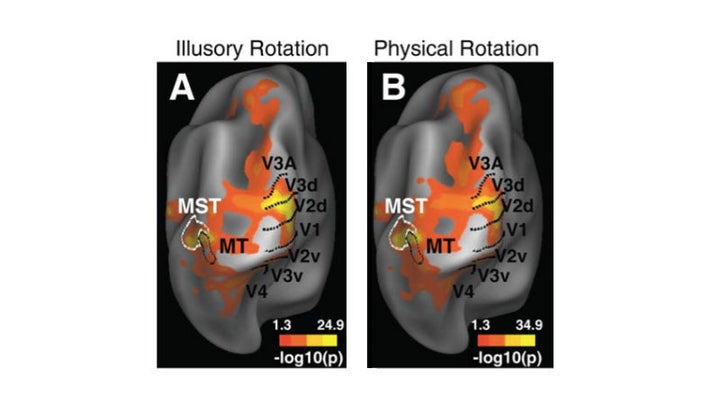The Pinna illusion is one of the best examples of why you should never fully trust your brain. It’s also the subject of two new studies that used brain scans to determine where in our heads reality breaks down and this illusion takes over.
If you’ve never seen the Pinna illusion, you're in for a treat. But fair warning: Engaging with this visual illusion involves moving your head in awkward ways, and may not be something you want to do in public.

Start by focusing on the dot in the center of the image above. Then, move you head toward and away from the screen.
Did the rings start rotating?
The probably seemed to -- but this is a perfectly still image created by Baingio Pinna in the 1990s, before GIFs had become popular. Still not sure? If you focus on one of the parallelograms, the rings will stop moving.
Visual illusions may just seem like fun mind-benders, but they are uniquely revealing of the inner workings of the brain and are therefore studied rigorously. In two separate recent neuroscience studies, teams of researchers asked volunteers look at the Pinna figure and a similar, animated illustration in which the rings actually did move. Meanwhile, fMRI brain scans monitored the participants' neurological activity.
Compared to what we know about other brain functions, we have a pretty good grasp on how the brain perceives images: It has to process millions of tiny electrical pulses it receives from the cells on the retina in the back of the eye.
Images are made of a variety of elements, including dots, straight lines, curved lines and colors. Different groups of neurons sitting in the visual cortex, which is located in the back of the head, are specialized to deal with each of these properties.
The first brain area to process input coming from the eyes is called V1. Other visual areas are called V2, V3, V4 and V5. Years of research has indicated that the V5 -- also known as the middle temporal, or MT -- is crucial for perceiving motion.
Researchers involved with both recent studies looked at all these visual areas to determine if the brain reacted differently to illusory and real motion.
The results suggest it doesn't.
Participants' MT areas became activated regardless of whether they looked at an illusory motion from the Pinna figure or watched real motion. In other words, as far as the motion-detecting part of the brain is concerned, the Pinna illusion is as real as it gets.

This confirms what scientists have long expected about the connection between the MT area and perceiving motion, said Ben Backus of the State University of New York College of Optometry.
"Even just imagining motion causes activities in this area," said Backus, who was not involved in either study. "So it's not surprising that looking at a physical stimulus that causes illusory motion would also evoke activity in these areas."
So this is where in the brain the Pinna illusion takes place. But how does it take place? The new research didn't answer this question, but Backus said there's a compelling theory.
The motion-detecting neurons in the MT receive their input from lower-level neurons in V1 and V2. Those neurons have a small receptive field, meaning they see as if through a pinhole. They gather what information they can and feed it to higher levels, such as the MT, to figure out the big picture.
But the V1 and V2 neurons are easy to fool. They don't directly respond to motion; they respond to changes in contrast over time, which Backus explains are usually caused by motion. So as the small parallelograms with their white and black edges move across the neurons' pinhole, each cell sees a shift in contrast and detects a motion.
But because of their small receptive field, these neurons have a hard time correctly identifying the direction of the motion.
"If you sweep a diagonal line through their receptive field, it will cause them to go gangbusters, even if the diagonal line is not moving in the direction that the neuron likes," Backus said. "Their receptive fields are so small they can't really tell the difference between a horizontal line moving down at 45 degrees or moving straight down at a slower speed."
Here's a demonstration of this problem -- the lines in this image could be moving to the right or straight down:

So these neurons feed an erroneous interpretation of the world to the higher-level areas -- and that's usually OK. These sorts of problems often occur in the peripheral vision, and all we need from our peripheral vision is to be able to quickly pick up on anything that's moving in the corner of our eye (a predator or a fast-approaching car, for example). Accuracy is the price to pay for that kind of speed.
"You just need to know that there's something there that's moving," Backus said. "It attracts your attention so you look at it directly, and now you can see it accurately."
